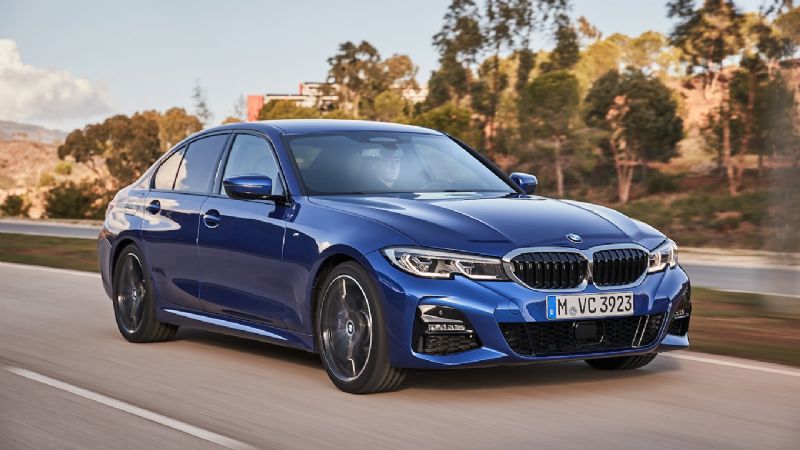2019 BMW 330i M Sport First Drive: Bavaria is Back

Can BMW deliver on the promise of the Ultimate Driving Machine once again? Over the past four decades, Bavarias sporting marque has endured tremendous pressure to constantly improve on what is seen as the segment benchmark. It is a cruel task. Improving one area often comes with a trade-off in another. BMW owners are as demanding as they are proud. Take it from someone who owned the 3 Series that really started it allthe 1988 E30 325ias well as the outgoing-generation 2012 F30 328i (and who has tested every generation in between). Were an arrogant bunch possessing sturdy right feet, and we have no qualms calling out missteps in handling and steering feel. The competition doesnt sit still, either. For those of you who track these things, the last two MotorTrend Car of the Year winners have been compact luxury sport sedans designed to dethrone the 3 Series as the default choice for shoppers in the segment. Both the COTY-winning Genesis G70 and Alfa Romeo Giulia make outstanding cases as the best-executed compact sport sedan extant. And the rival Mercedes-Benz C-Class has outsold the 3 Series for the past two years (although to be fair, Mercedes lumps sedans and coupes into C-Class sales, whereas BMW splits the sedan from the 4 Series coupe; if you add 3 and 4 Series sales, BMW still outsells the Mercedes C-Class ). But still, BMW is facing some stiff competitive winds. With the sixth generation of the 3 Series arriving in March, BMWs new G20 Series edition fires a response that will hopefully endear itself to loyalists and halt the wandering eyes of those shopping around. The incoming 330i is roomier, quicker, more adept, and a sharper performer. Segment creep persists. The 2019 3 Series carries 1.6 inches more wheelbase and 2.6 inches more overall length. As such, it has almost outgrown the conventional dimensional definition of a compact sport sedan. On the plus side, the added wheelbase length addresses the persistent 3 Series complaint about the lack of back seat space; it is now possible for a 6-foot-tall passenger to have sufficient legroom and footroom behind a 6-foot-tall driver without the driver having to scooch the seat forward. The 330is engine remains a 2.0-liter twin-scroll single-turbo, though it gains 7 hp (to 255) and a whopping 37 lb-ft (to 295). BMW claims a 060 time of 5.6 seconds (5.3 with all-wheel drive). Thats likely a conservative estimate, as MotorTrend testing of the 2017 330i delivered a 060 time of 5.5 secondsand the new 330i is lighter by 121 pounds, thanks to increased usage of aluminum and high-strength steels in the body-in-white, sheetmetal, and chassis. The turbo-four still features direct injection, variable valve lift, and variable cam timing, but the fuel pump now delivers 5,100 psi (compared to 2,900 psi of the old one). It also now has a split cooling system, separated for the cylinder head and crankcase. And twin exhaust tailpipes are standard (yay!). BMW says the new engine will also boast better fuel economy; kudos to the engineers who found the holy grail of performance and efficiency. Coming in summer 2019, the 340i variant will also keep its existing 3.0-liter twin-scroll single-turbo configuration but see impressive gains in power, delivering 382 hp (up 62) and 369 lb-ft (up 39) and an estimated 4.2-second 060 time (with xDrive AWD). Also, a 330e plug-in hybrid arrives this summer, with 37 miles of electric-only range and a 6.0-second 062 time. Theres also a trio of diesel variants, which Americans will never see, according to BMW. Also, the loss-leader depowered version of the turbo-four will not be offered, as BMW will likely bring the 1 Series sedan back to life at that price point. Then theres the look. BMW interior designer Bruno Amatino said the automaker considered more evolutionary styling but decided to be bolder instead. This was the largest step we could take without scaring the customer, Amatino explained. We wanted to make it look like we were skipping a generation. Yet for the most part, its still unmistakably BMWs design language. The kidney grille is more three-dimensional due to the revised hoodline, and the notched headlight housings feature laser lamps that can project nearly the length of six football fields. One key design note that BMW fans will debate, however: The famed Hofmeister kink that defines the C-pillar is now more of a chevron. BMW calls it a new interpretation, as the headliner of the back seat still keeps the original counter-swinging shape (the shadow of which can be seen from the outside if you squint). But the exterior detail has turned the distinct kink into a double-angled point that subtly aims toward the rear deck rather than visually directing ones gaze hard toward the rear axle to emphasize that this is a performance sedan. Purists may howl, but Amatino defended the new C-pillar, saying it was extended for visual length, in two movements. We wanted to extend the glass all the way to the edge of the door cut. Function over form, evidently. Inside, the 3 Series gets a thorough reworking. Unlike the X3 crossovers recent interior redo, which felt more like a mere freshening, the 3 Series interior changes are more dramatic. The slim dashboard is detailed by defined creases. Cool upscale touches abound, such as the knurled metallic prisms that form the edges of the vent-opening adjusters and iDrive knob. The leather surfaces and aluminum detailing wouldnt be out of place in a flagship vehicle. Every surface that falls to hand has an appropriately upscale feel, save for the plasticky response of the center consoles stowage tray lid. The sunroof is 4 inches longer. The instrument panel now has more room in the center for the trip computer information, not merely because the 8.8-inch screen is larger but also because designers reversed the swing of the right-side tachometerit now registers revs counterclockwise, which takes some acclimation. Designers also placed the center consoles display screen at the same elevation as the instrument panel to provide a horizon of information, Amatino said. However, in slightly reconfiguring the center console, BMW moved the gearshift and many control buttons rearward so that a driver must bow out their elbow and knuckle under their wrist to change many settings, compared to the easy user interface of the outgoing model. Perhaps most notably, changing driving modes is now accomplished by pressing individual buttons that are not identifiable by touch (the old model had a ridged rocker setup), so the driver must look away from the road to see what button they are pushing. Aside from a long-wheelbase version only for the Chinese market, BMW tuned the 3 Series identically for all the world, said Thomas Bumer, the cars project leader. Behind the wheel of the new 3er, the most noticeable element is the return of firmness to the suspension. The new car attacks road imperfections with a snooty impunity. BMW has installed standard hydraulic stop dampers on the rebound stroke up front and compression stroke in the rear; M Sport versions have an optional adaptive suspension with electronically controlled dampers. But even in Comfort mode, we received some hard jolts from the rear suspension when encountering sharp bumps and jouncesespecially in Sport mode. (Note, we were driving 330i M Sport trims, not the base suspension, so for those of you chasing the 330i lease-deal special, your suspension response may vary.) That said, the 2019 330i feels more planted. You can thank increased chassis rigidity (improved by up to a claimed 50 percent) as well as the front track being 1.7 inches wider and the rear track adding 0.8 inch. The speed-sensitive electric power steering seems to have more direct feel, as opposed to the too-light video game response of the outgoing modelalthough there was some vagueness in the range of 5 to 10 degrees off center with the M Sports variable sport steering. BMW claims a 50/50 weight distribution and a center of gravity lowered by 0.4 inch. The 330is brake pedal has a reassuring precision of response in nearly every situationeven with hard braking for a corner that has come on quicker than you expected. However, a spirited four-minute drive down a twisting Portuguese grade left the 330i M Sports front brakes smoking. BMW has delivered more intelligent semi-autonomous driving features, with increased hands-off driving assistance, reversing assistance to back out of tricky parking garages, and narrow passage support where lanes may have narrowed due to road construction. However, the lane keep assist programming is more insistent, snapping you sharply back into your lane if you approach the stripes. That could be a drawback when performing a courtesy pass of a bicyclist by inching into the oncoming lane; you could find yourself arm-wrestling the steering wheel to give the cyclist some space. As for the allegedly Intelligent Personal Assistant voice-recognition system, I found it not so smart . For nearly every voice command, the system either didnt recognize it or responded in error. For those commands it did recognize (Turn down the radio, or Im cold), it took far longer to execute than it would have taken me to merely reach out to rotate the volume knob or flick the temperature gauge. Although programmed to respond to Hey BMW, it frequently self-activated by someone merely saying BMW. As you know, BMW owners love to brag about their BMWs by saying BMW a lotmeaning the system frequently intrudes into conversations like an embarrassing mom chaperoning a teenage date. To be sure, BMW is far from alone in voice-command errata, but to label the system intelligent seems a bit of a misnomer. Theres also a revitalizing function if the driver is tired. The climate control fan pulsates at a chilly 64 degrees, the interior lights change color, and the stereo cranks up a weirdly hypnotic Euro-techno track (which actually made me feel drowsier). Standard features for all 3 Series buyers include LED headlights, a rain sensor, automatic headlight activation, a hands-free phone system, automatic climate control, cruise control with automatic braking, Bluetooth and USB connectivity, 18-inch alloy wheels, and split-folding rear seats. Since 1975, BMW has sold 15.5 million compact luxury sport sedans worldwide. Those owners tend to be as enthusiastic as they are demanding. Upon encountering the G20 3 Series, they should feel reassured that BMW has their best interests at heart. 2019 BMW 330i BASE PRICE $41,245 VEHICLE LAYOUT Front-engine, RWD/AWD, 5-pass, 4-door sedan ENGINES 2.0L/255-hp/295-lb-ft turbocharged DOHC 16-valve I-4 TRANSMISSIONS 8-speed automatic CURB WEIGHT 3,250 lb (mfr) WHEELBASE 112.2 in LENGTH X WIDTH X HEIGHT 185.4 x 71.9 x 56.8 in 0-60 MPH 5.3-5.6 sec (mfr est) EPA CITY/HWY/COMB FUEL ECON Not yet tested ON SALE IN U.S. March 2019 The post 2019 BMW 330i M Sport First Drive: Bavaria is Back appeared first on MotorTrend .
http://www.motortrend.com/cars/bmw/3-series/2019/2019-bmw-330i-m-sport-first-drive-review/




